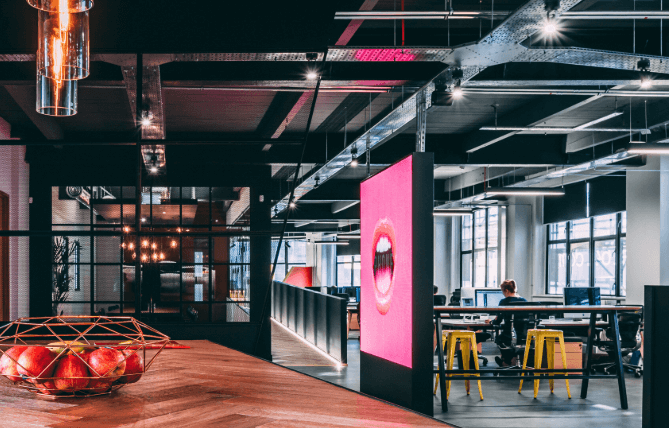Tips to Choose the Best Advertising Agency Office Interior

An advertising agency’s interior is more than simply a place to work; it’s a dynamic work environment that showcases professionalism, and inventiveness, in addition to originality. An advertising agency’s workplace should be a dynamic ecosystem that stimulates creativity, and promotes teamwork, along with stimulating innovative thinking, in contrast to standard corporate settings. Advertising professionals’ operational efficiency along with creative advertising agency office interior spirit is greatly influenced by their physical surroundings.
1. Crafting Creative Zones with Purposeful Design
A sophisticated approach to design that goes beyond traditional workplace layouts is necessary for creative environments. Dynamic settings that can easily switch between teamwork, client presentations, and individual brainstorming are ideal for advertising businesses. Think about designing multipurpose rooms that can be swiftly converted to accommodate various creative processes, such modular furniture that can be adjusted to match project requirements or flexible meeting places with moveable walls.
Designing areas that dismantle conventional hierarchical boundaries is crucial. Open-plan spaces that have spaces set aside for collaboration, inspiration walls, and creative nooks can promote impromptu ideation. Use design features that encourage visual thinking, including mood mapping pin boards, writing glass surfaces, and cozy seating configurations that encourage casual conversations.
2. Colour Psychology and Sensory Stimulation
Colour is a potent medium for communication that has a big impact on emotional reactions and creativity. The colour scheme for advertising companies should be thoughtfully chosen to inspire creativity while preserving a polished look. Think of combining vibrant accent colours that stand for originality and inventiveness with muted hues that offer visual serenity and concentration.
Texture, lighting, and spatial layouts are all part of sensory design, which extends beyond visual components. Use elements that appeal to a variety of senses, such as textured wall coverings, different lighting levels, and acoustic treatments that control soundscapes. Establish zones with varying emotional temperatures, such as tranquil areas for focused work, high-energy areas for brainstorming, and transitional spaces that provide mental rest in between intensive creative periods. The objective is to create an atmosphere that subtly encourages innovative thinking and cognitive flexibility.
3. Technology Integration and Workflow Optimization
In order to support intricate creative operations, modern advertising companies need to integrate technology seamlessly. Incorporate cutting-edge technology into the interior design to facilitate seamless collaboration, digital presentations, and multimedia production. Think about setting aside specific areas for digital showcasing, video conferencing, and software collaboration that may serve both local and distant team members.
When designing surroundings with a lot of technology, ergonomics are crucial. To accommodate various working styles, make investments in movable workstations, multi-monitor configurations, and adaptable power supplies. Provide places with cutting-edge audio-visual technology that can be swiftly converted from individual workstations to client presentation rooms, charging stations, and silent tech zones. While adhering to human-centric design principles, the interior should showcase advanced technology.
4. Wellness and Inspiration Ecosystem
Environments that put human well-being first and offer constant inspiration are conducive to creativity. Create wellness-oriented areas that let workers rest, work together, and get their minds going. Include features that blur the boundaries between work and leisure, such as interior green walls, natural lighting, and breakout rooms with cozy seats.
Think about designing multisensory areas to meet various psychological requirements. Mental rejuvenation may be found in a creative lounge with interactive displays, a peaceful meditation nook, or an inspiration library with well-chosen books and publications. These areas need ideally stimulate inquiry, promote casual conversations, and show the agency’s dedication to all-encompassing professional growth. The atmosphere is transformed from an office into a supportive space that fosters creativity and mental acuity.
5. Narrative-Driven Spatial Storytelling
An outstanding interior design for an advertising firm conveys a powerful visual narrative that embodies the company’s brand identity and creative ethos. Every aspect of the design, whether it be the choice of artwork, architectural features, or space arrangement, should convey the agency’s distinct approach to innovation. Build immersive spaces that represent the agency’s creative concept in three dimensions.
Utilize the interior as a platform to highlight client success stories, creative accomplishments, and the agency’s developing story. Create rooms that are easily adaptable for client presentations or team celebrations, design feature walls that showcase campaigns that have won awards, and construct digital galleries that circulate creative work. The interior turns into a vibrant narrative space that consistently conveys the agency’s inventiveness and creative strength.
Conclusion
The advertising agency office interior design is a complex art that calls for a thorough comprehension of human psychology, technology requirements, and creative workflows. With Officebanao, the goal is to establish a comprehensive setting that fosters innovation, encourages teamwork, and captures the fluidity of advertising professionals.



